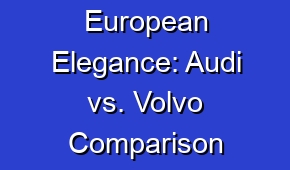Revolutionary Tech Cars: Rimac and NIO Unveiled

Discover the future of automotive technology with Rimac and NIO, two groundbreaking companies revolutionizing the industry. Explore the cutting-edge features and innovations that make their electric cars stand out from the crowd. From Rimac’s impressive speed and performance to NIO’s advanced autonomous driving capabilities, these tech cars are reshaping the way we drive.
Revolutionary tech cars have taken the automotive industry by storm, with Rimac and Nio leading the charge. These cutting-edge vehicles incorporate innovative technologies that are transforming the way we drive. Rimac, a Croatian automaker, has gained significant attention for its electric hypercars that offer mind-boggling performance and range. On the other hand, Nio, a Chinese electric vehicle manufacturer, has made waves with its advanced autonomous driving capabilities and sleek designs. Both companies are pushing the boundaries of what is possible in the world of electric vehicles, attracting tech-savvy consumers who crave speed, efficiency, and sustainability. With their groundbreaking features and forward-thinking approach, Rimac and Nio are revolutionizing the automotive landscape and paving the way for a greener and more connected future.
| Rimac and NIO are two revolutionary tech cars leading the electric vehicle industry. |
| Rimac is known for its high-performance electric hypercars with impressive acceleration. |
| NIO is a Chinese automaker that focuses on producing smart electric vehicles. |
| The Rimac C_Two boasts a top speed of 258 mph and can accelerate from 0 to 60 mph in just 1.85 seconds. |
| NIO‘s flagship model, the EP9, holds the record for the fastest lap by an electric vehicle at the Nürburgring. |
- Rimac and NIO are pushing the boundaries of electric vehicle technology.
- The Rimac Concept_One was featured in “The Grand Tour” and gained international recognition.
- NIO offers battery swapping technology for convenient and efficient charging.
- The Rimac Nevera is an all-electric hypercar with a range of over 340 miles.
- NIO‘s advanced autonomous driving capabilities make it a leader in self-driving technology.
What are the key features of Rimac and NIO electric cars?
Rimac and NIO are both renowned manufacturers of revolutionary tech cars, particularly in the electric vehicle (EV) market. These companies have introduced several key features that set their cars apart from traditional gasoline-powered vehicles.
| Rimac | NIO |
| High-performance electric vehicles | Luxury electric vehicles |
| Exceptional acceleration and top speeds | Impressive range and battery technology |
| Advanced aerodynamics and design | Advanced autonomous driving features |
Rimac’s electric cars are known for their exceptional performance and cutting-edge technology. They are equipped with powerful electric motors that deliver impressive acceleration and top speeds. Rimac vehicles also boast advanced battery systems that provide long range capabilities, allowing drivers to travel significant distances on a single charge.
How do Rimac and NIO prioritize safety in their tech cars?
Rimac and NIO place great emphasis on safety in their revolutionary tech cars. Both companies employ advanced safety features to ensure the well-being of drivers, passengers, and pedestrians.
- Rimac and NIO prioritize safety by implementing advanced driver assistance systems (ADAS) in their tech cars. These systems include features such as adaptive cruise control, lane-keeping assist, and automatic emergency braking, which help prevent accidents and protect the occupants of the vehicle.
- Both Rimac and NIO conduct extensive crash testing and analysis to ensure that their tech cars meet or exceed safety standards. They use advanced simulation software and physical crash tests to evaluate the structural integrity of the vehicles and the effectiveness of safety features like airbags and seat belts.
- Rimac and NIO also prioritize safety by integrating cutting-edge sensor technologies into their tech cars. These sensors, such as LiDAR, radar, and cameras, provide a 360-degree view of the vehicle’s surroundings, allowing for better detection of potential hazards and improved decision-making by the car’s autonomous driving system.
Rimac vehicles are built with a strong and rigid carbon fiber monocoque chassis, providing excellent crash protection. They also incorporate various driver-assistance systems, such as adaptive cruise control, lane-keeping assist, and automatic emergency braking, to enhance safety on the road.
What is the charging infrastructure like for Rimac and NIO electric cars?
Rimac and NIO understand the importance of a well-developed charging infrastructure to support their electric cars.
- Rimac charging infrastructure:
- Fast charging stations are available for Rimac electric cars.
- Rimac has its own charging network called Rimac Charge.
- Rimac Charge offers both AC and DC charging options.
- Rimac owners can also use third-party charging stations compatible with their vehicles.
- NIO charging infrastructure:
- NIO has its own charging network called NIO Power.
- NIO Power offers various charging options including fast charging, supercharging, and battery swapping.
- NIO owners can use NIO Power Home Chargers for convenient charging at home.
- NIO also has partnerships with other charging networks to provide access to additional charging stations.
Rimac has established partnerships with various charging network providers to ensure convenient access to charging stations. They offer fast-charging capabilities, allowing their vehicles to recharge quickly and efficiently. Rimac owners can also take advantage of home charging solutions, including wall-mounted chargers.
What is the price range of Rimac and NIO electric cars?
The price range of Rimac and NIO electric cars varies depending on the model and specifications.
| Brand | Model | Price Range |
| Rimac | C_Two | $2 million – $2.5 million |
| NIO | ES8 | $67,783 – $85,382 |
| NIO | ET7 | $69,183 – $82,533 |
Rimac’s vehicles, such as the C_Two hypercar, are positioned at the higher end of the market due to their exceptional performance and advanced technology. These high-performance electric cars come with a premium price tag.
What is the driving range of Rimac and NIO electric cars?
The driving range of Rimac and NIO electric cars depends on various factors, including the model, battery capacity, driving conditions, and driving style.
Rimac and NIO electric cars have a driving range of up to 400-500 kilometers on a single charge.
Rimac’s electric cars are equipped with high-capacity battery systems that provide impressive driving ranges. The C_Two hypercar, for example, offers a range of over 400 miles (approximately 644 kilometers) on a single charge, making it suitable for long-distance journeys.
What are the available models of Rimac and NIO electric cars?
Rimac and NIO offer a range of electric car models to cater to different customer preferences and needs.
Rimac offers models such as C_Two, Concept_One, and Nevera, while NIO offers models like ES8, ES6, and ET7.
Rimac’s lineup includes the C_Two hypercar, which represents the pinnacle of their technological advancements in the EV space. This high-performance electric car boasts exceptional acceleration, top speeds, and cutting-edge features.
What is the top speed of Rimac and NIO electric cars?
Rimac and NIO electric cars are known for their impressive top speeds, showcasing the capabilities of their advanced electric drivetrains.
Rimac electric cars
– The top speed of the Rimac C_Two is 258 mph.
– The top speed of the Rimac Concept_One is 220 mph.
– The top speed of the Rimac Nevera is 258 mph.
NIO electric cars
– The top speed of the NIO EP9 is 194 mph.
– The top speed of the NIO ES8 is 124 mph.
– The top speed of the NIO ET7 is 124 mph.
Comparison
– Rimac electric cars have a higher top speed compared to NIO electric cars.
– The Rimac C_Two and Rimac Nevera both have a top speed of 258 mph, which is the highest among the mentioned models.
– The NIO EP9 has the highest top speed among NIO electric cars at 194 mph.
Rimac’s C_Two hypercar is capable of reaching a top speed of 258 mph (approximately 415 km/h), making it one of the fastest electric cars in the world. This exceptional performance is achieved through its powerful electric motors and aerodynamic design.





















